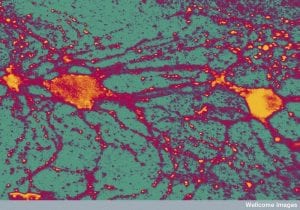
These neurons are found in hippocampal region of the brain, which is commonly associated with memory formation. A team of researchers has attempted to enable patients with hippocampal damage to establish long-term memories. (Source: Flickr)
Human trials are currently underway for a new study aimed to help patients with brain damage form long-term memories. Scientists at the University of Southern California and Wake Forest Baptist Medical Center have developed a brain prosthesis that has already demonstrated promising results in animal trials.
This prosthesis – designed to help patients with memory loss – is in the form of a collection of small electrodes placed into a person’s hippocampus, the brain region often associated with memory. Patients suffering from hippocampal damage frequently face difficulty establishing new long-term memories (1).
To understand how this prosthesis works, one must first be familiar with the process of long-term memory formation. The process begins with the delivery of sensory information (for example, the smell of baking bread) to the brain (1).
This new information then triggers an electrical signal that is transmitted throughout several distinct areas of the hippocampus. At each place the signal stops, it is re-encoded before proceeding to the next area, meaning the signal is actually different at the end of its trajectory than at the beginning (1). At the end of this journey, the signal is prepared for long-term storage (1).
This idea is similar to that of the popular game “Telephone,” where a sentence or phrase is repeatedly whispered from one person to the next in a long chain of people. By the chain’s end, the resulting phrase is actually an altered version of the original sentence.
The problem that occurs in the instance of hippocampal damage, which may arise from diseases like Alzheimer’s, is that one of these key stopping-points for the signal is damaged (1). The signal is not properly re-encoded and is later unable to be translated into long-term memory (1). This novel brain prosthesis allows the electrical signal to skip over the damaged region of the hippocampus by imitating how the region would normally re-encode the signal, allowing it to move to the next hippocampal area in the correct form (1).
Importantly, this study is not a way to understand the content or “meaning” of this electrical signal, but rather a way to understand the brain’s method of passing it along. Ted Berger, one of the researchers from USC, explains, “It’s like being able to translate from Spanish to French without being able to understand either language” (1).
The scientists developed this technique by first examining patients who already had electrodes implanted in their hippocampal regions for the purpose of treating seizures (1). They studied the signals at two isolated points of the hippocampus and then developed an algorithm to express the relationship between these two areas.
Once they had a working version of the algorithm, they began to test its predictability. This was done by selectively looking at the electrical signal from just the first of the two brain regions. Based on this data, the algorithm would then predict the translation that would occur at the second area (1).
So far, after hundreds of trials, the algorithm has attained a level of 90 percent accuracy (1). The final step in the study will be to put one of these translated signals into the brain of a patient with hippocampal damage to see if long-term memory formation is still possible.
References:
1. University of Southern California. (2015, September 29). Scientists to bypass brain damage by re-encoding memories: New prosthesis aims to help people living with memory loss. ScienceDaily. Retrieved October 3, 2015 from www.sciencedaily.com/releases/2015/09/150929142524.htm
Leave a Reply